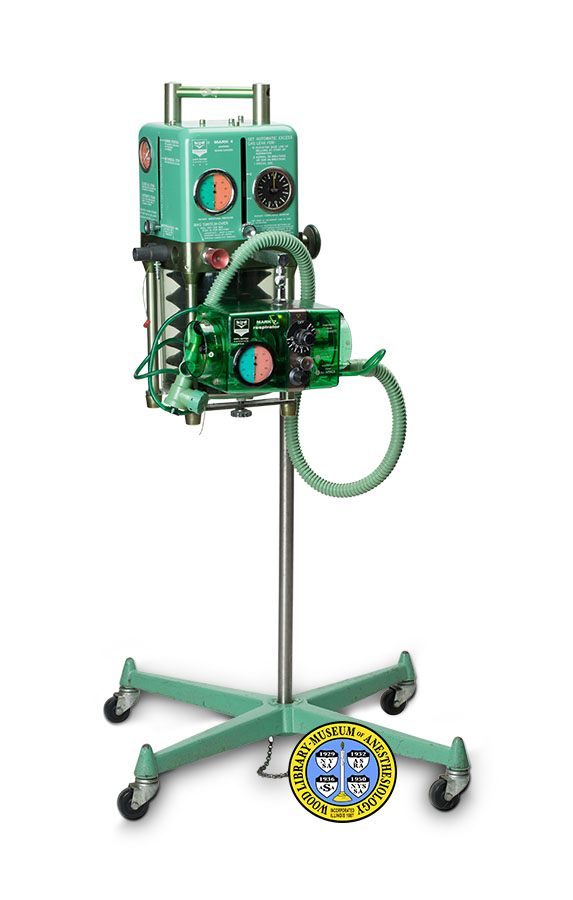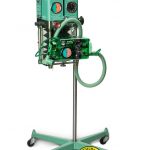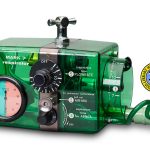Bird Mark 7 Respirator
The Bird Corporation was founded by Forrest M. Bird, M.D., Ph.D. (1921-2015). Dr. Bird invented a number of popular medical devices that were used to care for patients with breathing problems. During WWII he served in the Army Air Corps where, in addition to training and transport assignments, he studied aircraft and respiratory and cardiovascular problems at high altitude. Two devices that he produced during the war went into the design of his first commercial ventilator, the Mark 7 Respirator. A ventilator is a machine that helps a person breathe or takes over the work of breathing completely.
The Mark 7 was introduced in 1957, when American physicians were beginning to use ventilators in greater numbers. For use during anesthesia, the ventilator was attached to the Bird Mark 4 Assistor/Controller, introduced in 1959. Bird's early ventilators were manufactured for Bird by the National Welding Company, which later made the carbon dioxide electrodes for the three-function blood gas analyzer. The Mark 7 Respirator continued to be produced into the 1980s. Dr. Bird was inducted into the National Inventors Hall of Fame in 1995, and in 2008 he received the National Medal of Technology and Innovation.
Catalog Record: Bird Mark 7 Respirator Bird Mark 7 Respirator
Access Key: amwl
Accession No.: 2011-05-09-1 B
Title: Mark 7 Respirator / Bird Corporation.
Author: Bird, Forrest M. (Morton), 1921-2015.
Corporate Author: Bird Corporation.
Title variation: Alt Title
Title: Bird Residual Breather Mark 7.
Title variation: Alt Title
Title: Bird Universal Medical Respirator.
Publisher: Palm Springs, California : Bird Corporation, [between 1957 and 1978?].
Physical Description: One respirator : metals, plastics ;
Subject: Ventilators, Mechanical.
Subject: Respiration, Artificial – instrumentation.
Subject: Anesthesia, Inhalation – instrumentation.
Web Link: https://www.woodlibrarymuseum.org/museum/item/1003/bird-mark-7-respirator
Note Type: General
Notes: The title is taken from the object. The first year in the date range is based on a history of the Mark 7 Respirator, in the Company File. The history “encompasses ten years” of development which began in 1947. The second year in the date range is based on the date that the company was acquired by 3M. The WLM archives holds references to the Bird Corporation, in Palm Springs, dating from 1960 through 1975.
The front of the apparatus is considered that side on which the controls are mounted.
The cataloged object belongs with Acc. # 2011-05-09-1 A. It was married to Acc. # 1998-08-13-1 A1 for purposes of photography.
Note Type: Citation
Notes: Bird Company File. Archives. Located at: Wood Library-Museum of Anesthesiology, Schaumburg, Illinois.
Note Type: Citation
Notes: Bird Corporation. Specifications for the Visible bird Mark 7 Simplex Positive Phase Medical Respirator. Richmond, CA: Bird Corporation, 1966. In: Bird Company File. Archives. Located at: Wood Library-Museum of Anesthesiology, Schaumburg, Illinois.
Note Type: Citation
Notes: Bird Products Corporation. Bird Mark 7 and Mark 7A Respirators, Service Manual. Palm Springs, CA: Bird Products Corporation, 1986. In: Bird Company File. Archives. Located at: Wood Library-Museum of Anesthesiology, Schaumburg, Illinois.
Note Type: Citation
Notes: Hunter AR. Essentials of Artificial Ventilation of the Lungs, 2nd ed. London: J. & A. Churchill, 1966.
Note Type: Citation
Notes: McFadden RD. Dr. Forrest Bird, inventor of medical respirators and ventilators, dies at 94. New York Times. August 3, 2015. http://www.nytimes.com/2015/08/04/us/dr-forrest-bird-inventor-of-medical-respirators-and-ventilators-dies-at-94.html?_r=0. Accessed August 28, 2015.
Note Type: Citation
Notes: Mushin WW, Rendell-Baker L, Thompson PW, Mapleson WW. Automatic Ventilation of the Lungs, 2nd ed. Oxford: Blackwell Scientific Publications, 1969:358-363.
Note Type: Citation
Notes: Severinghaus JW. History of blood gas analysis. III. Carbon dioxide tension. J Clin Monit. 1986;2(1):70.
Note Type: Physical Description
Notes: One respirator; Consists of a rectangular housing and connecting hoses; The translucent green plastic housing alone measures approximately 17 x 25.5 x 16.5 centimeters; The back and bottom sides of the housing are unmarked; A metal band wraps around this housing to the right of center; On the top of the unit, this metal band is stamped: “677 1175”; A metal connector extends through the top of the unit and through this band; This is the connector by which the Mark 7 can be attached to a Bird Mark 4 Assistor/Controller machine;
On the top side of the unit, to the right of this band, the white markings have worn so that some of the text is lost; The remainder reads: “DESIGNED FOR PUBLIC USE [new line] UNDER PROFESSIONAL ENGI” [new line] NEER LIC. NO. [illegible] 2849 STATE [new line] OF CALIFORNIA BY H. L. [new line] POHNDORF [illegible] BIRD [new line] U.S. & FOREIGN [illegible] S [new line] APPLIED FOR [further lines illegible];
The front of side of the unit is divided into two unequal sections by the metal band; To the left of this metal band, the housing is marked: “MARK 7 [new line] respirator”; In the upper left corner, the housing is marked with the company’s logo: “bird [new line] corporation [new line] palm springs [new line] california [new line] u.s.a.”; Below this there is a needle gauge, divided into two zones; The zone on the left half of the gauge is blue (or aqua) and is marked: “10, 20, 30, 40, PRES.”; The zone of the right half of the gauge is orange (or pink), and is marked: “10, 20, 30, 40, VAC”.
Mounted on the same metal band, on the front side of the unit, are three control knobs; The largest of these knobs is uppermost; This knob is made of black metal, and has a dial marked: “Off, 5, 7, 10, 15, 20, 25, 30, 35, 40”, with radial lines; To the right of this, the housing is marked with the number “5” in a white circle with an arrow pointing left toward this knob; To the right of this number the housing is marked in white: “inspiratory [new line] time [new line] FLOWRATE”;
Below this a second, unmarked, knob made of silver-toned metal; To the right of this, the housing is marked with the number “2” in a white circle with an arrow pointing left toward this knob; To the right of this number the housing is marked in white: “for pulmonary conformance [new line] pull out [new line] AIR-MIX”;
Below this is a third control consisting of metal ring and a black plastic knob; This ring is marked: “40 [over] 25″, 20”, “15 [over] 10” and “7 [over] 5″‘; To the right of this knob the housing is marked with the number “3” in a white circle; To the left of this number is the word “DECREASE”, with an upward-pointing arrow; below this number is a downward-pointing arrow marked “OFF”; To the right of this number the housing is marked in white: “expiratory [new line] time [new line] for APNEA”;
The corrugated hose is made of opaque green plastic and is approximately 2 centimeters in diameter; This hose is approximately 122 centimeters long including the connectors at each end; Both of these connectors are made of opaque green plastic with a metal ring; Both of these connectors are marked: “bird”; The connector on one end of this hose enters an opening in right side of the housing; The same connector has a translucent green vinyl hose that enters a second, smaller opening beside the first;
Note Type: Physical Description
Notes: The connector at the opposite end of the hose is fitted into one of two T-shaped connectors, set at right angles to one another; The first T connector is marked: “bird [new line] 999 2576 [new line] patented [new line] 1968”; The arm of this first T connector is open; Both the end and the side arm of the second T connector are capped; The cap on the arm is made of opaque green plastic, and is marked: “USE [new line] RETARD BY [new line] PRESCRIPTION”; The end cap on the second T connector is made of translucent green plastic, and is marked: “bird [new line] 9993 172”; This cap holds two translucent green vinyl hoses; These two hoses enter a connector that meets the end of the hose at different points;
On the right side panel of the housing, a ring of translucent green plastic extends approximately 3 centimeters outward from the panel; This is marked with the number “1” in a white circle; From back to front, additional markings include: “inspiratory PRESSURE limit” and the numbers “40, 25, 20, 15, 10, 7, 5”; A black plastic indicator extends from inside the housing to the exterior of this ring; The corrugated hose enters the housing just below this ring;
A similar ring extends outward from the left side panel of the housing: This is marked with the number “4” in a white circle: From back to front, additional markings include: “inspiratory SENSITIVITY effort”, and the numbers “5, 7, 10, 14, 20, 40”; a black plastic indicator extends from inside the housing to the exterior of this ring; There are no markings on the back or bottom panels of the housing.
Note Type: Reproduction
Notes: Photographed by Mr. Steve Donisch, January 13, 2016.
Note Type: Acquisition
Notes: Gift of Borris Borotinski, M.D.
Note Type: Historical
Notes: Forrest M. Bird, M.D., Ph.D. (1921-2015) invented a number of popular medical devices that were used to care for patients with breathing problems. During WWII he served in the Army Air Corps where, in addition to training and transport assignments, he studied aircraft and respiratory and cardiovascular problems at high altitude. Two devices that he produced during the war went into the design of his first commercially released ventilator, the Mark 7. A ventilator is a machine that helps a person breathe or takes over the work of breathing completely.
Dr. Bird founded the Bird Oxygen Breathing Equipment Company in Palm Springs, California, around 1954. The Mark 7 was introduced in 1957, when American physicians were beginning to use ventilators in greater numbers. At the time, only a few other ventilators were available in the U.S. The Mark 7 was smaller and lighter than the others and was one of the first ‘pneumatically driven’ ventilators. This means it was powered by compressed gas from a cylinder or piped source, and did not require electricity to function.
For inhalation anesthesia, the Mark 7 was used in concert with an anesthesia machine and Bird’s Mark 4 Assister/Controller. The Mark 4 Assister/Controller was introduced in 1959. The Bird Mark 8 and Mark 10 Ventilators, introduced a few years later, could also be used together with an anesthesia machine and the Mark 4. During anesthesia, the ventilator was used to adjust the rate of flow, timing, and pressure of the gases delivered to the patient’s lungs.
According to John W. Severinghaus, M.D., the early Bird ventilators were manufactured for Bird by the National Welding Company. Dr. Bird recommended this company to manufacturer the carbon dioxide electrodes that were used in the first three-function blood gas analyzer designed by Dr. Severinghaus and Mr. Freeman Bradley, introduced in 1959. By 1960, the name of Dr. Bird’s company had changed to Bird Corporation. In 1978, it was sold to 3M, and the name changed again to Bird Products Corporation. The Mark 7 continued to be produced into the 1980s. Dr. Bird was inducted into the National Inventors Hall of Fame in 1995, and in 2008 he received the National Medal of Technology and Innovation.
Note Type: Exhibition
Notes: Selected for the WLM website.



